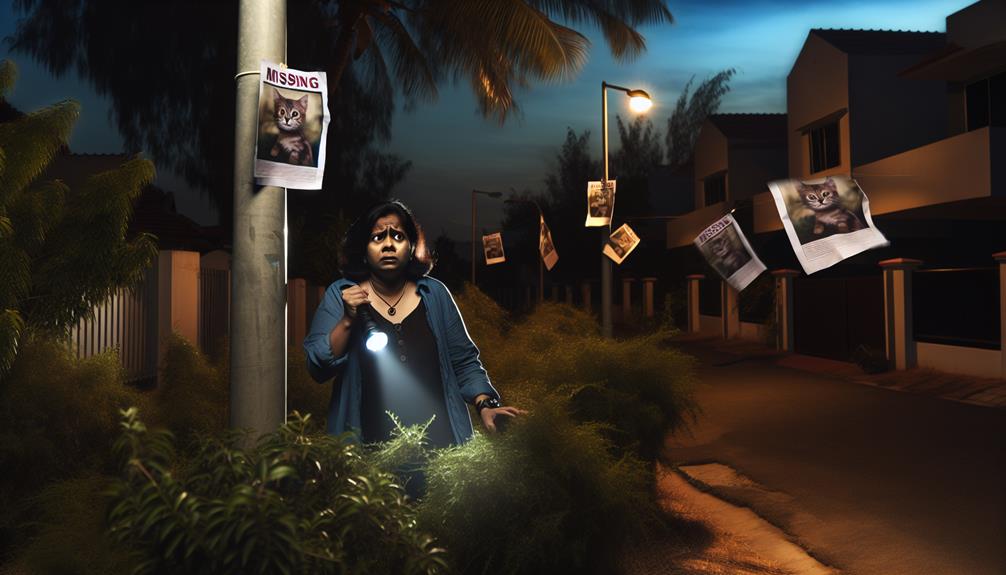Losing a cat can be a bit of an adventure, but it's important to approach the search methodically. Begin by meticulously combing through your home, as cats often find the most unexpected hiding spots. Once you've ruled out the indoors, engage your neighbors by sharing flyers and utilizing social media platforms. Combining hashtags with recent photos can greatly increase your chances of locating your feline companion. But there's more to reflect on—have you thought about contacting local shelters or even utilizing advanced tracking tools? Let's explore some effective strategies to reunite you with your furry friend.
Search Your Home
When searching for your lost cat, it's vital to begin by thoroughly examining your home. Cats are notorious for finding obscure hiding spots, so an initial, meticulous search within your living space is essential. Start by identifying common search areas where your cat might have a tendency to retreat. These include secluded places like under beds, inside closets, and behind large furniture.
Next, methodically inspect each room. Pay special attention to areas that offer warmth and concealment. Check behind appliances, inside laundry baskets, and even within the folds of blankets or piles of clothing. Utilize a flashlight to peer into dark corners and small crevices that might not be immediately visible.
Remember that cats can squeeze into surprisingly tight spaces. Evaluate nooks and crannies that seem improbable, such as behind bookshelves, within cabinets, or even inside boxes. It's also advisable to take into account vertical search areas. Cats often climb to high locations, so inspect the tops of cabinets, shelves, and other elevated surfaces.
During your search, maintain a calm demeanor to avoid startling your cat, which could cause it to retreat further into its hiding spot. Softly call out your cat's name and listen for any responsive sounds, such as meowing or movement. Additionally, try placing familiar items, like your cat's favorite toy or blanket, in various locations to lure it out.
Ultimately, a thorough and systematic examination of your home, focusing on both common and unconventional hiding spots, will increase the likelihood of locating your lost cat. Prioritizing precision and thoroughness in your search efforts is key to a successful recovery.
Alert Neighbors
Informing your neighbors is essential when searching for a lost cat. Distribute flyers with your cat's photo and your contact information, and utilize neighborhood social media groups to spread the word quickly. These actions increase the chances of someone spotting your cat and notifying you promptly.
Spread the Word
An effective strategy to locate your lost cat involves spreading the word among your neighbors. Engaging in community outreach and utilizing word of mouth can greatly enhance your search efforts. By alerting those around you, you exponentially increase the number of eyes looking for your feline friend.
To effectively spread the word, consider the following steps:
- Create Flyers: Design clear, concise flyers with a recent photo of your cat, contact information, and any distinctive features. Distribute these in mailboxes, community boards, and public spaces.
- Talk to Neighbors: Face-to-face conversations can be invaluable. Inform your immediate neighbors and expand the circle to nearby streets. Personal interactions often leave a lasting impression.
- Contact Local Businesses: Visit nearby stores, pet shops, and veterinary clinics. Request permission to post your flyer and ask employees to keep an eye out.
- Utilize Community Groups: Engage with local community groups, such as neighborhood associations and pet rescue organizations. They often have the resources and networks to aid in your search.
- Set Up a Phone Tree: Organize a phone tree with neighbors willing to help. This guarantees rapid dissemination of information if your cat is spotted.
Utilize Social Media
Leveraging social media can be a powerful method to alert your neighbors about your lost cat. By taking advantage of platforms like Facebook, Twitter, and Instagram, you can quickly disseminate information to a broad audience. Hashtags effectiveness cannot be understated; use relevant hashtags such as #LostCat, #MissingPet, and your location to enhance visibility.
Community engagement is essential. Posting in local groups or neighborhood-specific pages can mobilize a concentrated effort. Encourage your neighbors to share your post, increasing the likelihood of reaching someone who may have seen your cat.
Here's a concise strategy to maximize your social media efforts:
| Step | Action |
|---|---|
| 1 | Write a detailed post with a clear photo of your cat. |
| 2 | Use relevant hashtags to boost visibility. |
| 3 | Share in local community groups. |
Use Social Media

Social media platforms can be invaluable tools in your search for a lost cat. Utilizing these digital networks effectively can greatly increase your chances of locating your missing feline. First, consider leveraging hashtag strategies to enhance the visibility of your posts. Including commonly used hashtags such as #LostCat, #MissingPet, or #FindFluffy can guarantee that your message reaches a broader audience. Additionally, create a unique hashtag specific to your cat to streamline searches across various platforms.
Engaging with community groups on social media is another vital strategy. Local neighborhood groups, pet recovery pages, and city-specific forums can provide immediate assistance and relevant leads. Post a clear, concise message detailing your cat's description, any distinctive features, and the last known location. Visual aids, such as photographs and videos, can enhance the efficacy of your posts.
You should also consider the following actions to maximize your social media outreach:
- Join and post in local lost and found pet groups: These groups often have members who are actively looking out for lost pets and can offer assistance.
- Share your post on personal profiles and request friends to share: The broader the network, the higher the chances of someone spotting your cat.
- Utilize Instagram Stories and Facebook Stories: These features can increase engagement and guarantee your post remains visible.
- Monitor comments and messages closely: Rapid responses to inquiries can facilitate faster coordination and information exchange.
- Update your posts regularly: Continuous updates maintain interest and remind people to keep an eye out.
Employing these social media tactics can greatly augment your efforts to reunite with your lost cat, leveraging the power of community and technology.
Create Lost Cat Flyers
When creating lost cat flyers, focus on clear, concise design and include essential information. Make sure to feature a recent, high-quality photo of your cat, and provide contact details, the cat's name, and any distinctive markings. Place the flyers in high-traffic areas to maximize visibility.
Flyer Design Tips
Designing an effective lost cat flyer requires attention to detail and strategic placement of information. To maximize the flyer's impact, consider the following expert tips:
- Color Choices: Utilize bright colors like neon yellow or orange as they attract attention. Confirm the text contrasts sharply with the background for readability.
- Font Styles: Select easy-to-read fonts such as Arial or Helvetica. Avoid decorative fonts that can be challenging to decipher quickly.
- High-Quality Images: Use a clear, high-resolution photo of your cat. Ideally, the image should show the cat's face and any unique markings.
- Layout: Structure your flyer to guide the reader's eye. Place the most critical information at the top. Confirm there's ample white space to avoid a cluttered look.
- Call-to-Action: Include a clear call-to-action. Phrases like "Please Help Find Fluffy!" or "Call Now if Seen" can prompt immediate action from the reader.
Essential Information Needed
To create an effective lost cat flyer, it's essential to include important information that will help others identify and locate your missing pet quickly. Begin with a clear, recent photo of your cat. This visual aid is significant for immediate recognition. Include your cat's name, as calling their name might help in approaching them.
Describe specific physical characteristics such as color, breed, size, and any unique markings. Note their collar and any tags if applicable. Mentioning their typical lost cat behavior, such as being shy or friendly, informs people how to approach them.
Provide details on common hiding spots where your cat might seek refuge, such as under porches or in garages. This can direct search efforts to likely locations. It's also beneficial to specify the date and location where your cat was last seen, narrowing down the search area.
Include your contact information—phone number and email address—ensuring people can reach you immediately. Offering a reward can incentivize people to assist in the search. Keeping the flyer concise yet thorough increases the likelihood of a swift reunion with your lost cat.
Check Local Shelters

As part of your search strategy, visiting local animal shelters can be vital in recovering your lost cat. To maximize the effectiveness of this approach, you must employ a systematic method. Begin by identifying all animal shelters within your vicinity. This includes municipal shelters, private rescues, and even veterinary clinics that might house lost pets temporarily.
First, check the hours of operation for each shelter. It's important to know when they're open so you can plan your visits efficiently. Shelters often have varied schedules, and some may require appointments, so gather this information beforehand.
When you arrive at a shelter, visit staff immediately. Communicate clearly about your lost cat, providing a detailed description and any distinctive features. Staff members are trained to handle such situations and can offer valuable assistance.
Here's a checklist to make sure you cover all bases:
- Check hours: Confirm the operational hours of each shelter.
- Visit staff: Introduce yourself and provide detailed information about your lost cat.
- Bring photos: Keep recent pictures of your cat to show staff and leave copies if necessary.
- Follow-up: Regularly contact the shelters for updates on new intakes.
- Leave contact info: Make certain shelters have your phone number and email for immediate communication.
Utilize Tracking Tools
Why not leverage modern technology to enhance your search efforts? In today's digital age, various tracking tools can markedly augment your chances of finding a lost cat. One such tool is the GPS collar. These devices allow real-time tracking of your cat's location, offering peace of mind and actionable data. Paired with sophisticated tracking apps, you can monitor your pet's movements and receive immediate alerts if they wander outside a predefined area.
Understanding animal behavior is vital. Cats often follow scent trails, whether their own or those of other animals. This knowledge helps when using neighborhood maps to identify likely hiding spots or frequent routes. Printing a detailed map of your area and marking these locations can streamline your search process.
Microchip registration is another fundamental component. Confirm your cat's microchip information is up-to-date. This simple step can make a notable difference, as local veterinarians and shelters often check for microchips when a stray animal is found.
Moreover, various pet recovery services specialize in locating lost pets. These services employ a range of techniques, from specialized search teams to scent-tracking dogs, to find missing animals. Engaging these services can add a professional touch to your search efforts, increasing the likelihood of a successful outcome.
Lastly, don't overlook the value of consulting with local veterinarians. These professionals can provide valuable insights and may have already received information about a found cat matching your description. Utilizing these advanced tracking tools and resources will surely enhance your search efficiency and improve your chances of reuniting with your lost feline companion.
Conclusion
In summary, finding your lost cat requires a multi-faceted approach. Have you considered the peace of mind you'll gain by thoroughly searching your home and utilizing tools like GPS collars? By alerting neighbors, leveraging social media, creating effective flyers, and regularly checking local shelters, you greatly increase your chances of a successful reunion. Remember, each step is essential in ensuring your feline friend's safe return. Take action now, and don't leave any stone unturned.
